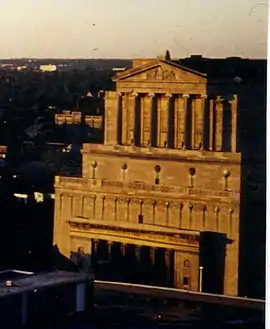New Masonic Temple (St. Louis)
The New Masonic Temple is a historic building in St. Louis, Missouri, built in 1926. Like many other buildings built for Freemason meeting places, it shows Classical Revival architecture.
| New Masonic Temple | |
|---|---|
 | |
| Location | 3681 Lindell Boulevard, St. Louis, Missouri |
| Built | 1926 |
Named a city landmark in 1976, the more than 386,000-square-foot building stands 185 feet high and has more than six million cubic feet of space. There are 14 levels with six full floor and eight mezzanine levels. The Temple's ground was broken in 1923 and dedicated in 1926. Created by well-known architectural company Eames & Young with consulting architect Albert B. Groves, it features classic Greek Ionic style exterior architecture with various styles throughout the interior.
The Masonic Temple is built in three receding stages, which is symbolic of the three steps in Masonry. Constructed of Bedford limestone with gray granite trim, the main lobby is finished in marble with other rooms featuring its original wool carpet. One of the property's many highlights is an unfinished theater with 2,200 seats.
The lobby has a 38-foot mural titled “The Origins of Freemasonry”, which was created in 1941 by Jessie Housley Holliman and dedicated by Senator Harry S. Truman. It is the only surviving mural by noted African American artist Holliman in a St. Louis public building.
The Temple's history includes many prominent guests. It houses the former office of then-Senator and Freemason Grand Master Harry S. Truman before he became President of the United States. Charles A. Lindbergh was initiated and participated as a mason at the Temple before his renowned 1927 flight. In 1980, Escape from New York with Ernest Borgnine filmed a scene on the Temple's steps. Borgnine, a Mason, attended Masonic meetings in the building.
The ground and first floors and the first-floor mezzanine have areas where the general public is admitted only on days when a meeting is held, which is currently 10 per month. The second floor contains the Eastern Star quarters. Third and fourth floors and their mezzanines were designed to house the Blue Lodges with the potential for eight Blue Lodge halls. The four halls and the fourth floor were not completed, and one area on the third floor was made into a dining room.
Fifth and sixth floors were designed to house three of the York Rite organizations, which are known as the Chapter, Council and the Commandery. Most of the building is non-sectarian, but the fifth floor features Christian symbolism. The fifth level hall is 100’ long, 75’ wide and 48’ high.
See also
- Moolah Temple of the Mystic Shrine, at 3821 Lindell Boulevard, completed in 1912
- Scottish Rite Cathedral (St. Louis), at 3627 Lindell Boulevard, completed in 1924
External links
- Webpage about the history of the Lindell neighborhood
- German Wikipedia article